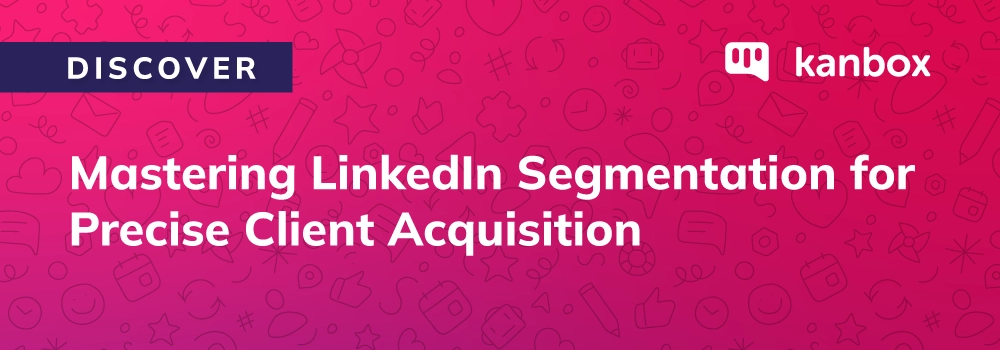Mastering LinkedIn Segmentation for Precise Client Acquisition
Segmentation on LinkedIn is much more than just dividing your audience; it's a complex strategy that allows you to precisely target your prospects and optimize your client acquisition.
In this article, we'll delve into the various aspects of LinkedIn segmentation and explore how to implement them to maximize your results.
Understanding Marketing Segmentation: Grasping and Acting
In the intricate world of marketing and sales, segmentation plays a crucial role. But what exactly do we mean by marketing segmentation?
Defining Marketing Segmentation
Marketing segmentation involves dividing your market into distinct groups, called segments, that share similar characteristics. These common criteria can vary: needs, expectations, buying behaviors, and more.

This essential approach helps you better understand your audience. Imagine having glasses that allow you to see each segment distinctly in a crowd. That's precisely what it does—providing a clearer vision to meet each group's specific expectations.
The Persona as a Starting Point: Going Beyond Traditional Segmentation
When thinking about marketing segmentation, we often think first of the different types of clients targeted in B2C. In B2B, the focus typically shifts to targeting specific companies.

However, in B2B Sales, you're contacting an individual, even though they represent their company, not their personal needs or desires.
Thus, you mix personas with the company by default: different industries, company sizes, roles, and professions. Yet, before focusing on Sales, you need to consider Marketing Segmentation. This involves thinking beyond "what interests me about my prospect" and asking instead, "what interests my prospect that might align with what I offer?" or "what are the specific pain points of this prospect, and how can I address them?"
Why Is Audience Segmentation Important?
As we've seen, audience segmentation allows you to divide a large audience into smaller, more homogeneous groups based on specific criteria such as industry, position, company size, and more. This allows companies and sales teams to create more precise messages, which correlates with higher conversion rates.

By segmenting your audience, you can more accurately understand who your clients are and what their needs are. This enables you to create messages that resonate with them, leading to greater engagement in your outreach efforts.
Additionally, audience segmentation can help you identify new market opportunities, improve your products and services, and increase your return on investment.
The 3 Key Systems for B2B Market Segmentation
The 3 main criteria for Sales segmentation are:
- Geographic Criteria: such as country or city, or even a specific area within a city.
- Sociodemographic Professional Criteria: the type and size of the company, the targeted role, the industry, the age of the targeted individuals, and more.
- Psychographic Professional Criteria: you need to create personas to understand the challenges, needs, interests, or pain points of this target to personalize your approach, not just based on market needs or company type, but on the individual contacted on LinkedIn.
The Benefits of LinkedIn Segmentation
Segmenting with Adaptation to Available Information
Once you've categorized your audience's various criteria, it's beneficial to align them with your LinkedIn target. You can identify four primary criteria to derive from your LinkedIn target, allowing you to cross-reference traditional segmentation criteria.

- Professional Criteria: industry, company size, role, hierarchy level.
- Demographic Criteria: geographic location, age, gender.
- Behavioral Criteria: interactions with your content, browsing history on LinkedIn, participation in groups.
- Interest Criteria: topics followed, types of content shared, professional training.
By combining these dimensions, you can create highly specific segments that enable precise targeting of the most relevant prospects for your business.
Why Segment Before Any B2B Sales Campaign
It's a simple exercise, but it can make a significant difference when you harvest the results of your outreach campaigns!
Personalization of communication: by tailoring your message to each segment, you increase engagement and strengthen the relevance of your interactions.
Better understanding of your audience: by segmenting, you get a clearer view of your prospects' needs and preferences, allowing you to adjust your offer and strategy accordingly. You can also test different approaches (based on friction points, challenges, expectations) and compare the results of these approaches to better adapt to each segment later on.
Optimization of return on investment: by precisely targeting the most promising segments, you maximize the effectiveness of your campaigns and reduce unnecessary costs.
Implementing Effective Segmentation on LinkedIn
To implement effective B2B market segmentation on LinkedIn, follow these steps:
A/ Define Your Goals
Identify what you want to achieve through segmentation and determine the relevant criteria to use.
B/ Collect Data
Use the tools available on LinkedIn to collect data on your audience and identify common characteristics of each segment.
C/ Create Specific Campaigns
Utilize LinkedIn's targeting features and your marketing personas to create personalized campaigns for each segment, ensuring operational and needs-based segmentation.
D/ Analyze and Adjust
Monitor the performance of your campaigns and adjust your strategy based on the results obtained.
To help you with your segmentation strategy, we've prepared a TOP 10 list of outreach tools that allow you to manage your segmentation.
These tools scrape key information from LinkedIn Sales Navigator according to your LinkedIn segmentation logic and even allow you to enrich or refine this segmentation before launching your Sales Automation campaigns.

By following these steps, you'll be able to implement effective segmentation on LinkedIn and optimize your client acquisition with precision.
Segmentation on LinkedIn is a crucial element of any successful client acquisition strategy. By understanding the various dimensions of segmentation and implementing them strategically, you can maximize the efficiency of your campaigns and achieve meaningful results for your business.
Start today by exploring the segmentation possibilities on LinkedIn and stand out from the competition by precisely targeting the most relevant prospects for your business.


